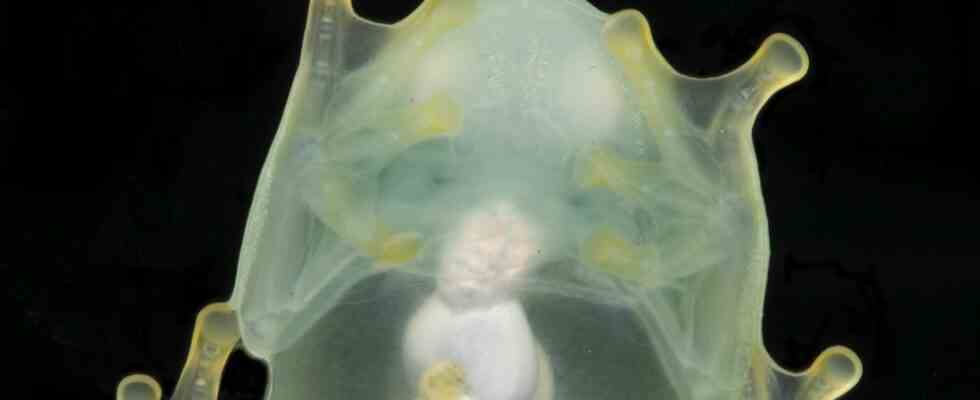To maintain their transparency, glass frogs hide their red blood cells, which are visible through the skin, in the liver when they sleep. This helps them become virtually invisible to predators, reports an American research team in the specialist magazine Science. How they manage to rearrange the blood cells on a massive scale without clogging their blood vessels is still unclear.
Glass frogs live in the tropical rainforests of Central and South America. Their upper surface is colored translucent green, the skin on the underside is translucent, as are the muscles. This camouflages the nocturnal animals as they rest on green leaves during the day. In vertebrates – which include frogs – creating transparency is a challenge because the circulatory system is full of hemoglobin-containing red blood cells, the researchers write.
In order to find out how the animals overcome this hurdle, Sönke Johnson’s team from Duke University in Durham examined glass frogs of the species Hyalinobatrachium fleischmanni using special microscopic and spectroscopic methods. They used this to determine the transparency of the animals and the distribution of the red blood cells in the body – while the frogs were sleeping, active or anesthetized.
During sleep, the animals’ transparency increased by 34 to 61 percent, the measurements showed. This was because the number of circulating blood cells decreased massively – by 80 to 90 percent. The blood cells accumulated in the liver during this time. Another result: Only a very small part, 3.4 percent, of the red blood pigment hemoglobin was loaded with oxygen during this time. Hemoglobin picks up oxygen in the lungs and transports it throughout the body. The researchers therefore assume that the oxygen-consuming metabolic activity of the glass frogs is reduced during sleep.
As soon as the animals become active, the red blood cells flow back into the circulatory system, the researchers continue to report. In other tropical, non-transparent frogs, they found no such displacement of blood cells. In most vertebrates, a local accumulation of blood cells leads to clumping, i.e. to thrombosis, the scientists write. Glass frogs are therefore possibly a good model for studying vascular diseases in humans.
In addition to this research approach, there are numerous other questions that should be clarified in follow-up studies, write Nelly Cruz and Richard White from the Memorial Sloan Kettering Cancer Center in New York in a comment on the study. “It is unclear whether glass frogs can actively manipulate changes in red blood cell circulation – for example in the presence of a predator.” It is also not yet known whether environmental factors or behavior of the animals, such as food availability or the mating season, influence the condition.

